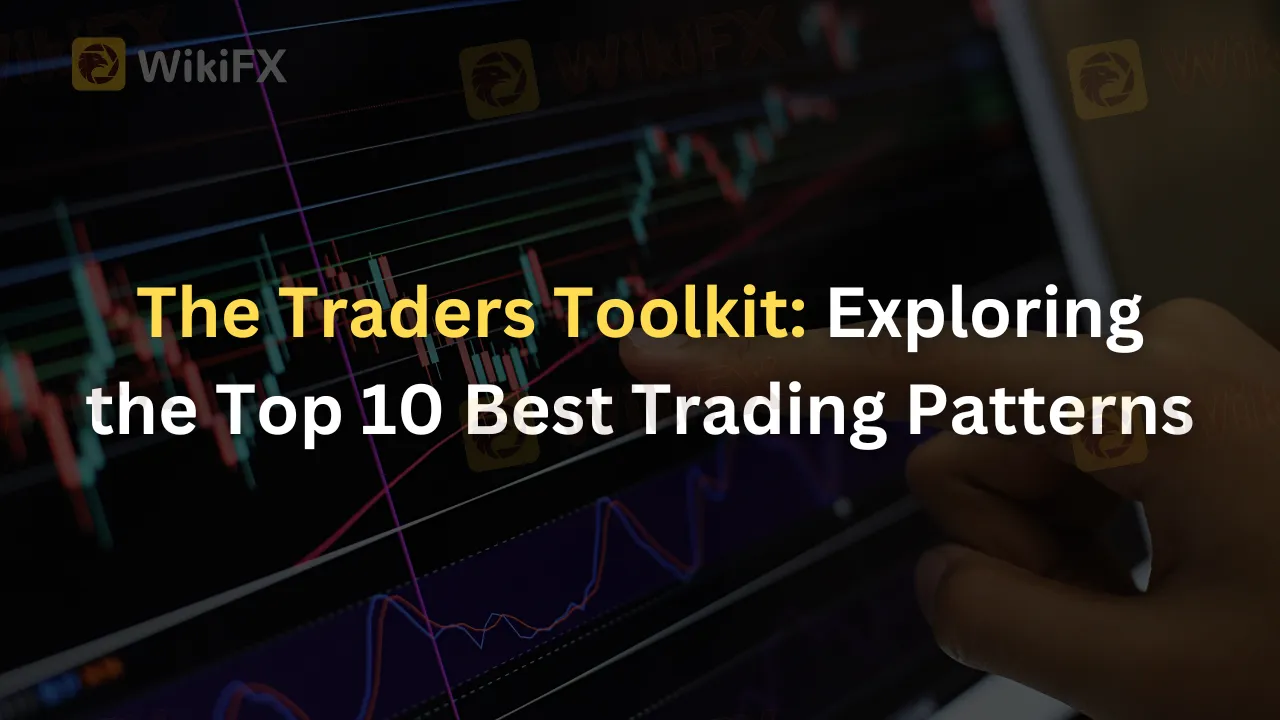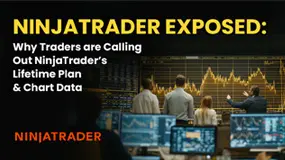简体中文
繁體中文
English
Pусский
日本語
ภาษาไทย
Tiếng Việt
Bahasa Indonesia
Español
हिन्दी
Filippiiniläinen
Français
Deutsch
Português
Türkçe
한국어
العربية
The Traders Toolkit: Exploring the Top 10 Best Trading Patterns
Abstract:This article outlines the top ten most commonly used trading patterns, including Head and Shoulders, Double Top and Bottom, Cup and Handle, Triangle, Flag and Pennant, Wedge, Candlestick Patterns, Fibonacci Retracement, Elliott Wave Theory, and Harmonic Patterns. These patterns aid in predicting market trends, facilitating strategic trading decisions.

In the dynamic, multifaceted realm of trading, patterns are as integral as compasses to explorers. They function as a form of technical analysis, providing insight into the ebbs and flows of market trends, and offering traders potential opportunities for strategic decision-making. This article aims to unpack the intricacies of the top 10 most commonly used trading patterns, their potential indicators, and the respective strategies they could prompt.
Head and Shoulders Pattern
The first pattern under our microscope is the 'Head and Shoulders' pattern. Just as the name suggests, this formation mirrors the shape of a head with two shoulders. It's considered a reliable predictor of a potential reversal in a bullish (upward) trend. The pattern typically appears at the peak of an upward trend, with the left shoulder forming first, followed by the head (a higher peak), and finally, the right shoulder, mirroring the left. The baseline, or 'neckline', connects the lowest points of the two troughs. The pattern is confirmed when the price falls below the neckline following the formation of the right shoulder. This could signal a sell-off, indicating a potential shorting opportunity for traders.
Double Top and Double Bottom Patterns
The Double Top and Double Bottom Patterns act as the canaries in the coal mines of trading, potentially signaling a reversal after a prolonged trend. A 'Double Top' pattern forms during an uptrend, with the price reaching two consecutive peaks of nearly equal height, separated by a moderate trough. The pattern completes when the price falls below the lowest point of the trough, signaling the possibility of a trend reversal from bullish to bearish. On the flip side, a 'Double Bottom' pattern forms during a downtrend, with the price reaching two consecutive lows before rebounding. Upon breaking above the highest point of the intermediate peak, a reversal from a bearish to a bullish trend could be underway.
Cup and Handle Pattern
The Cup and Handle Pattern can be likened to a coffee cup with a handle, where the 'cup' signifies a correction, and the 'handle' a smaller, subsequent correction before a potential bullish breakout. The pattern typically begins with a downward trend (the left side of the cup), followed by a round-bottomed consolidation period (the base of the cup), then a smaller, short-term pullback (the handle), before a definitive upward breakout. This pattern is seen as a bullish continuation signal, indicating potential buying opportunities after the breakout above the handle.
Triangle Patterns
Triangle Patterns, comprising ascending, descending, and symmetrical triangles, are popular forecasting tools used to predict the continuation of a trend. An ascending triangle is identified by a rising lower trendline and a horizontal upper trendline, indicating bullish sentiment. A descending triangle, conversely, has a falling upper trendline and a horizontal lower trendline, suggesting bearish sentiment. The symmetrical triangle, with converging trendlines, suggests that the market is consolidating, and a breakout could occur in the direction of the prevailing trend.
Flag and Pennant Patterns
The Flag and Pennant Patterns are similar in construction and function as continuation patterns that typically follow a sharp price movement. These patterns represent brief pauses in a prevailing trend before its resumption. Flags appear as small rectangles (the flag) tilted against the prevailing trend, connected to the preceding sharp price movement (the pole). Pennants, on the other hand, are small symmetrical triangles that form after a significant price movement. A breakout from these patterns usually continues in the direction of the preceding trend, offering potential trading opportunities.
Wedge Patterns
Rising and falling wedges are seen as potential reversal patterns. A rising wedge, forming during an uptrend, is delineated by converging trendlines with a noticeable upward slant. It often indicates that the uptrend is losing strength and a bearish reversal could occur. Conversely, a falling wedge forms during a downtrend and is characterized by converging trendlines with a downward slant, hinting at a potential bullish reversal.
Candlestick Patterns
Candlestick patterns, originating from ancient Japanese rice trading, are a plethora of distinctive formations offering varied signals. The 'Doji' is a pattern signifying indecision, where opening and closing prices are virtually equal. A 'Hammer' is a bullish reversal pattern appearing at the end of a downtrend. 'Engulfing' patterns, both bearish and bullish, indicate potential reversals, where a new candle's body 'engulfs' the previous candle's body. The 'Shooting Star' pattern is a bearish signal appearing at the end of an uptrend. These, among others, offer a rich tapestry of potential trading signals when understood in the context of the prevailing market.
Fibonacci Retracement
Fibonacci Retracement is a tool based on the Fibonacci sequence, a mathematical principle discovered by Leonardo Fibonacci in the 13th century. Though not a pattern itself, traders use it to predict potential levels of support (price stops falling) or resistance (price stops rising). By identifying the high and low of a recent trend, traders can apply Fibonacci ratios (23.6%, 38.2%, 50%, 61.8%, and 100%) to forecast potential price reversals. These levels may guide traders in placing strategic entry and exit orders.
Elliott Wave Theory
The Elliott Wave Theory, proposed by Ralph Nelson Elliott, is a comprehensive theory that predicts market trends by identifying crowd psychology manifesting in waves. A complete Elliott cycle consists of eight waves: five impulse waves in the direction of the trend and three corrective waves against it. Within this, a multitude of sub-patterns exist. Learning to read these patterns can provide a deep understanding of market cycles and potential future price movements.
Harmonic Patterns
Last but not least, Harmonic Patterns elevate the understanding of geometric price patterns. These complex patterns use Fibonacci numbers to predict potential future price movements. Famous examples include the Gartley pattern, the Bat Pattern, the Butterfly Pattern, and the Crab Pattern. These patterns identify potential reversals with a high degree of accuracy but require a significant amount of practice and precision to master.
Conclusion
The landscape of trading patterns is as diverse and nuanced as the market itself. From the simplicity of the Head and Shoulders Pattern to the complexity of Harmonic Patterns, traders have an array of tools in their arsenal to navigate the ebb and flow of market trends. It is imperative to remember, however, that these patterns do not guarantee success. They are tools to guide decisions, not foolproof predictions of future movements. Knowledge and understanding of these patterns, combined with disciplined strategy execution, risk management, and a bit of market luck, may pave the way to a trader's success.
Download and install the WikiFX App on your smartphone to stay updated on the latest news.
Download the App here: https://social1.onelink.me/QgET/px2b7i8n

Disclaimer:
The views in this article only represent the author's personal views, and do not constitute investment advice on this platform. This platform does not guarantee the accuracy, completeness and timeliness of the information in the article, and will not be liable for any loss caused by the use of or reliance on the information in the article.
Read more

Seaprimecapitals Withdrawal Problems: A Complete Guide to Risks and User Experiences
Worries about Seaprimecapitals withdrawal problems and possible Seaprimecapitals withdrawal delay are important for any trader. Being able to get your money quickly and reliably is the foundation of trust between a trader and their broker. When questions come up about this basic process, it's important to look into what's causing them. This guide will tackle these concerns head-on, giving you a clear, fact-based look at Seaprimecapitals' withdrawal processes, user experiences, and trading conditions. Most importantly, we'll connect these real-world issues to the single most important factor behind them: whether the broker is properly regulated. Understanding this connection is key to figuring out the real risk to your capital and making a smart decision.

iFX Brokers Review: Do Traders Face Withdrawal Issues, Deposit Credit Failures & Free Coupon Mess?
Have you had to pay several fees at iFX Brokers? Had your trading profit been transferred to a scamming website, causing you losses? Failed to receive withdrawals from your iFX Brokers trading account? Has your deposit failed to reflect in your trading account? Got deceived in the name of a free coupon? Did the broker officials not help you in resolving your queries? Your problems resonate with many of your fellow traders at iFX Brokers. In this iFX Brokers review article, we have explained these problems and attached traders’ screenshots. Read on!

NinjaTrader Exposed: Why Traders are Calling Out NinjaTrader’s Lifetime Plan & Chart Data
Did NinjaTrader onboard you in the name of the Lifetime Plan, but its ordinary customer service left you in a poor trading state? Do you witness price chart-related discrepancies on the NinjaTrader app? Did you have to go through numerous identity and address proof checks for account approval? These problems occupy much of the NinjaTrader review online. In this article, we have discussed these through complaint screenshots. Take a look!

Questrade Review Pros, Cons and Regulation
Is Questrade legit? Yes—CIRO regulated broker offering stocks, ETFs, forex, CFDs, bonds, and more with low fees and modern platforms.
WikiFX Broker
Latest News
GGCC Bonus and Promotions: A Data-Driven Analysis for Experienced Traders
Close Up With WikiFX —— Take A Close Look At Amillex
CapEx Spending On AI Is Masking Economic Weakness
Questrade Review Pros, Cons and Regulation
AccentForex Review: Is It Safe to Invest or Scam?
Is Your Money Safe? The Capital.com Withdrawal Mystery Revealed
World Forex Review: Does the Broker Deny Withdrawals and Scam Traders via Fake Bonuses?
Revolut Expands in South Africa with Banking Licence Move
The Broker Dilemma: Why Your Choice Could Make or Break Your Forex Journey
【WikiEXPO Global Expert Interviews】Sheikh Muhammad Noman: The Future of Investment in the GCC
Currency Calculator



